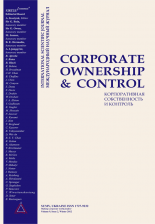New issue of the Corporate Ownership and Control journal

It is a great pleasure to present a new issue of the journal in 2019. The recent volume of the journal “Corporate Ownership and Control” examines several relevant topics in the international framework such as the role of corporate governance in financial institutions both in Italy and in international contexts, the governance system in Italy, with a specific focus on the adoption of gender quotas and on risk disclosure. Two very interesting researches that highlight, respectively, the determinants of the voluntary disclosure and the importance of international accounting standards in South America, complete the issue.
In particular, Lagasio performs a systematic literature review of published papers on risk management, compensation and ownership structure of banks and runs a meta-analysis. She shows that bank performance are positively related to board ownership, CEO ownership and ownership concentration by the controlling shareholder, while State ownership leads to lower bank performance.
Kasraoui and Kalai focus on a sample of Tunisian banks and analyze the characteristics of internal and external governance mechanisms that affect banking efficiency. The authors show how market competition has improved banking efficiency and information transparency. Consequently, all Tunisian banks allocate better both their financial resources and productivity.
Similarly, Wakaisuka-Isingoma investigates the relationship between corporate governance and performance in a unique sample of 103 financial institutions in Uganda. The econometric results highlight the existence of a positive link between several governance proxies and performance.
Moving on the analyses of Italian companies, Dell’Atti, Sylos Labini and Di Biase examine the board of directors in view of the changes introduced by Solvency II. The findings, obtained also through a survey, underline a satisfactory level of compliance of the board with respect to the requirements established by Solvency II.
Rizzato, Busso, Devalle and Zerbetto build a Corporate Governance Index, by looking at 15 different items, for a sample of 159 listed companies and identity the determinant of the compliance of the corporate governance structure of Italian companies. The econometric results show a moderate level of compliance with the Italian and international corporate governance standards, with differences depending on the size of the company.
Netti investigates the relationship between firm characteristics, such as size, industry, board of directors’ independence, ownership structure and leverage, and risk disclosure in the Italian context. The results suggest that, in the Italian context, despite the recent interventions from the legislator to improve risk disclosure in corporate reporting, there is a remarkable difference between the disclosure provided by large and small sized companies.
Pastore shows the effect of the gender quota Law on board of Italian listed companies. The author highlights, from a theoretical perspective, both the advantages and disadvantages related to the introduction of Golfo-Mosca law and suggests some future challenges for the governance of Italian companies.
Gros and Koch construct a compliance score and a quality score in order to shed light on the determinants of the observed low levels of compliance and voluntary disclosure. The researchers reveal that firms determine their level of disclosure strategically and show that the association between disclosure determinants and disclosure behavior is influenced by the enforcement environment.
Villanueva García, Cordova Román and Cuenca Jiménez study the application of International Financial reporting Standards on a sample of large Ecuadorian and Colombian companies. The results show a different impact between the two countries and display a greater impact only in the Colombian case. In the Ecuadorian case, although the country had made an effort to get closer to international standards with the NEC, they had remained at a distance.
To browse the issue, please, visit the following link.
We hope that you will enjoy reading this issue of our journal!
















